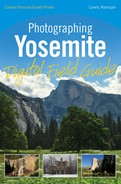16.3. How Can I Get the Best Shot?
You can either use the mountain peaks as backdrops for large scenic images or use a longer lens to zoom in and isolate the peaks.
16.3.1. Equipment
Using a wide-angle to moderate telephoto lens works best for this scene. Adding a tripod and bubble level helps you get good depth of field and have level images.
16.3.1.1. Lenses
Wide-angle lenses in the 14-35mm range are the most effective when trying to photograph the peaks as part of the larger landscape. With this focal length, you can use either the river or the reflecting pond as a strong foreground element or be able to emphasize the sky if you have good clouds.
Using short telephoto lenses makes the mountains more prominent and the foregrounds less imposing, and using longer telephoto lenses enables you to fill the frame with the peaks themselves.
16.3.1.2. Filters
The most useful filters you can use when photographing Mount Dana and Mount Gibbs are a polarizing filter and a graduated neutral density filter.
Polarizing filter. Useful for reducing glare and reflections off the surface of the water and rocks.
Graduated neutral density filter. This filter is useful for balancing your lighting ratios, especially when you are photographing with a darker foreground and lighter background. A graduated neutral density filter has a gradient of density that reduces light at the top of the filter and tapers to clear, having no effect at the bottom of the filter. If the sky is much brighter than the foreground, you can use this filter to even out the lighting ratios between the bright sky and the darker foreground. Because the filter is dark at one end and clear at the other, you place the dark end over the sky to reduce the brightness of that area and even out the light so that the bright sky and the darker foreground, which in these locations would include the Dana Fork or the reflecting pond, can both be exposed properly in one exposure.
16.3.1.3. Extras
A tripod and electronic cable release help you keep the camera steady when working with longer exposures. A bubble level helps you keep the horizon level.
16.3.2. Camera settings
When photographing these peaks, I like to put them in context with their surroundings, so having the proper depth of field to ensure sharp foregrounds and backgrounds is my main concern.
ISO. Using the native ISO of your camera (the ISO recommended by your camera manufacturer) always gives you the best image. If you are handholding the camera, you may want to use ISOs around 400 to 800 so that you can get good depth of field and have a fast enough shutter speed to hold your camera steady.
Exposure mode. To ensure proper depth of field, you want to control your aperture, so using Aperture Priority mode is the best choice. If you are using a tripod, the shutter speed is not a great concern.
Exposure compensation. If you are including a lot of foreground, you may end up overexposing the clouds or sky. This happens if the meter is picking up a lot of the ground and using that value to determine exposure. If that is the case, use an exposure compensation of −1/2 to 1 stop to correct for this and get properly exposed skies and clouds.
White balance. Daylight white balance should work well, but if your images are too blue due to the high elevation, try using a setting of Shade or Cloudy to compensate for that.
16.3.3. Exposure
Getting a good exposure for this image is fairly easy, especially if the sun is in the west!
16.3.3.1. Ideal time to shoot
The ideal time to photograph these peaks is in the afternoon when the sun is lighting their faces. Anytime from 1:00 p.m. until sunset should be fine. The mountains take on a red glow at sunset.
16.3.3.2. Working around the weather
Good clouds are a big help when photographing the peaks because they add drama and interest to the image, but any weather is good. Because you only have access to the peaks in the summer to fall when the Tioga Pass Road is open, the weather is usually good. One element that can add a lot of drama to a picture of the peaks is an early snowstorm in the fall.
16.3.3.3. Low-light and night options
The peaks are not ideal subjects for night photography.
16.3.3.4. Getting creative
Reflecting the peaks in the pond is one way to get creative. You could photograph the reflection only and not include the peak if you want to try something different.


